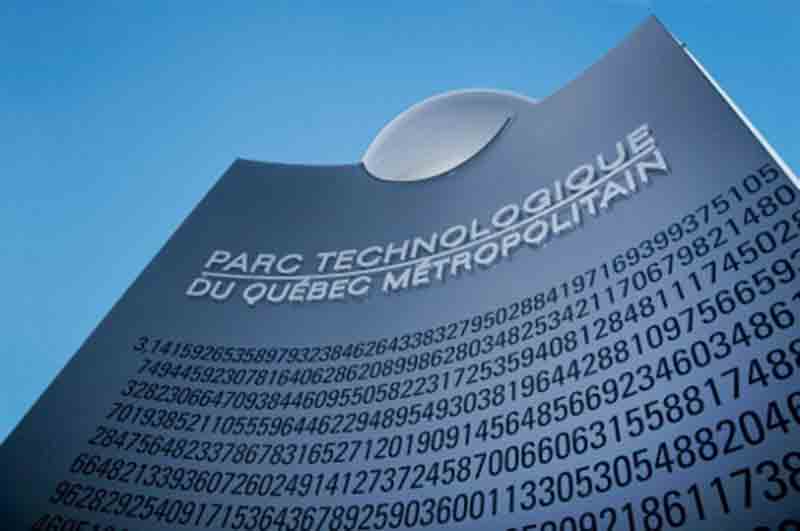A community built on skill, ideas and a will to innovate
By Cheryl Long
Canada’s first technology park, founded in Quebec City in 1988, is a glowing example of innovation combined with a vision for the future. Its focus is attracting, supporting, and providing services to forward-thinking companies that combine entrepreneurship with new technologies. The Quebec Metro High Tech Park is a leader in its field, encouraging initiatives and growth inside the park community and contributing to the greater good of the community at large.
The Quebec Metro High Tech Park is now home to approximately 100 businesses and 6,000 high qualified workers.
“Companies are looking for plug and play. They need a business environment that’s simple,” said Natalie Quirion, the park’s CEO. “They have their own core business. What we want is to support them as they grow within their own core business.”
Ms. Quirion has been part of the Park for 16 years, contributing her entrepreneurial spirit, business administration background and experience in strategic planning to the Park’s success. As President of the North American Division of IASP (International Association of Science Parks and Areas of Innovation), she has both been witness to and inspired by the huge growth and success of technology parks over the years — a number that has risen to approximately 25 and includes such renowned developments as the MaRS Discovery District in Toronto, the Edmonton Research Park in Alberta and the David Johnston Research + Technology Park in Waterloo, Ontario. She has made it her business to exchange ideas and share with these parks, and she strongly believes that by sharing and collaborating everyone can win. It’s an idea that she brings to her team and to the Park.
The Quebec Metro High Tech Park began as a provincially-owned corporation that brought together government, university and business as a means of attracting innovative and entrepreneurial people to Quebec. Primarily through the launch of start-up companies, the goal was to commercialize scientific discoveries and their resulting products and, in turn, find ways to support the Park’s tenants in many aspects. In 1999, the original business model was set aside in favour of establishing a new private, non-profit corporation that would self-finance through land sales as the Park’s primary source of income. Today, that model has continued to evolve to offer new services that help diversify the Park’s revenue sources, Ms. Quirion said. Real estate development and expanded business services are among the ventures that help support the dynamic, high tech environment.
“They have their own core business. What we want is to support them as they grow within their own core business.” Natalie Quirion, CEO
From optic and photonic to vaccines and urban sciences
The list of companies residing in the Park is an extensive one with many specializing in the fields of optics and photonics, life sciences (vaccines and diagnostics), software development, medical devices, environmental analysis and much more. Along with its tenants, the Park also collaborates with a group of partners that share a sense of vision, innovation and values in development and excellence: Université Laval, INRS, the City of Quebec and Quebec International, the region’s economic development agency.
Fostering those partnerships and building new ones is important to Ms. Quirion. “We want to create another kind of alliance inside the region. We’re very well-organized for innovation and we want to be sure that everybody can take advantage of this force,” she said. “It’s important to benefit from all opportunities, trying to connect more and more of those people.”
Opportunity is at the heart of the Park. Many of its residents launched their companies as start-ups, run by a single person or a small group of innovators. Ms. Quirion has seen several of those small businesses grow to become global entities, helping to put Quebec “on the map” and attract both talent and investment to the region. But that doesn’t mean just anyone is a good fit for the Park’s environment. Businesses that invest in research and development, focus on innovation and have their eye on the international market are the types of organizations that flourish inside the community.
“We want to create another kind of alliance inside the region. We’re very well-organized for innovation and we want to be sure that everybody can take advantage of this force,” she said. “It’s important to benefit from all opportunities, trying to connect more and more of those people.”
Medicago is a Quebec ecosystem success story
One such success story is Medicago, which develops vaccines and therapeutic proteins using an exclusive production process based on the genetic engineering of plants. The company, which began years ago as a small group of researchers, attracted international attention and was eventually acquired in 2013 by Japan-based Mitsubishi Tanabe Pharma. Last fall, the company was awarded a contract by the Public Health Agency of Canada to develop two antibodies to fight the Sudan strain of the Ebola virus. BD Diagnostics is another successful business within the Park, hiring hundreds of employees and making substantial investments in the community, Ms Quirion said.
Another startup, B-TEMIA Inc., is a private medical device company specializing in human augmentation systems, which work to enhance and preserve human mobility and independence. The market is a growing one, projected to be worth close to $675 million by 2020. Last November, B-TEMIA initiated a clinical trial aimed at demonstrating the benefits and safety for home use of its Keeogo technology, a powered assistive Dermoskeleton technology for patients with reduced mobility.
LeddarTech is also a startup located inside the Park. The company is the world’s only supplier of advanced detection and ranging solutions using patented Leddar sensing technology, performing time-of-flight optical detection. The technology has a cost advantage over traditional sensors, which will benefit automakers as they implement advanced driver assistance systems (ADAS) in the mainstream car market. LeddarTech was recently awarded the 2015 North American Frost & Sullivan Award for Product Innovation for its Leddar sensing technology.
Plans for future construction
Quebec Metro High Tech Park is aiming to continue its momentum with a long-term plan to construct new buildings over the next several years. This will allow the Park to welcome companies that are evolving and growing, Ms. Quirion explained, and encourage ongoing collaboration between businesses as well as university and government resources. “This is what we are doing best — to connect people. It’s simple to do that but it’s important to do that,” she added.
The growth is also key to increasing the number of high tech jobs in Quebec, which were lacking in the 1980s, Ms. Quirion said. Graduates were forced to leave the province to find work in their fields but today, companies within the Park are creating hundreds of jobs across several sectors. Being able to retain high levels of skill and expertise is a plus for the province, and it also helps Quebec companies compete on a more international scale.
“We have a lot of talents, expertise and equipment in Quebec but now one of our focus is to create more and more, to be better, to work together … and we’re looking to be efficient.”
That forward-thinking focus is looking strongly to technology of the future, from automation and 3D printing to the Internet of Things. Being on top of advances in technology is one of the best ways that the Park can stay relevant for their clients, Ms. Quirion explained.
“This is what we’re looking for inside Quebec. What is our plan to support our companies? Do we have the right digital infrastructure to support our companies? This subject is one of our strategic orientations — to be sure we have all we need to support our clients in the future.”
To learn more about Quebec Metro High Tech Park and the businesses within its community, visit www.parctechno.com.







